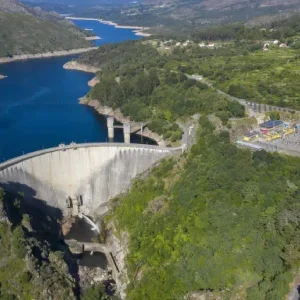Over the last 20 years, wind turbine technology has developed dramatically. The first generation of industrially produced turbines was based on a 5 metre blade. The turbines had rotor diameters of 10-11 metres, and were equipped with a 22-30 kWe generator. Machines from this generation were primarily sold from 1978 to 1981.
The second generation started with a 55 kWe turbine with a 15 metre rotor, later upscaled to a 75 kWe machine with a 17 metre rotor. This generation dominated the market in the first half of the 1980s. It was based on a 7.5 m blade from Alternegy.
The third generation consisted of turbines based on a 9 m blade, with generators of 90-100 kWe. This generation was dominated by LM Glasfiber and Vestas. Sales of this generation peaked in 1987.
The fourth generation of turbines ranged between 150 and 250 kWe, based on 12 m blades. This size range dominated the market from the late 1980s to the early 1990s.
The fifth generation consisted of 300-400 kWe machines with 14 m blades, later extended to 500 kWe machines with 39 m diameters.
A sixth generation of machines in the range 500 kWe to 1 MWe with rotor diameters of up to 50 m was developed in the mid 1990s.
The current seventh generation has seen capacities rise above 1 MWe. This generation is partly the result of the European WEGA R&D programme. Sizes range from 1 to 1.65 MWe, with rotor diameters up to 66 m. The Vestas 1.65 MWe unit is currently the largest wind turbine in serial production. Unit capacity of this generation is expected to increase to 2 MWe.
Increase in efficiency
At the same time as the size of wind turbines has increased, productivity has also increased. Productivity is measured as annual electricity production divided by the rotor area of the machine. Productivity rose from less than 500 kWh/m2 in 1981 to 1000 kWh/m2 in 1997. This is as a result of improved technology, including better micro-siting methodologies, and greater hub heights.
Reduced noise emission
One of the main issues for development has been noise emission. As a general rule, total noise emissions increase with increased turbine size. Compared with earlier technology, noise emissions from modern turbines increases less steeply in relation to size, so new turbines are relatively less noisy than older ones.
Cheaper wind turbines
Comparing the ex-factory price per kWe of fourth generation (1991; 150-225 kWe) with sixth generation (1997; 600 kWe) machines, the price has fallen by 20 per cent. Other investment costs (foundation, grid connection, roads, etc) have fallen by 50 per cent, and electricity production costs have fallen by 30 per cent. This is as a result of:
Technological development;
Manufacturing improvements;
Increasing machine size;
Increase of market volume.
Manufacturing and quality
Over the last 20 years, manufacturing commercial wind turbines has become increasingly industrialised. Increased economies of scale have accrued, and ease of manufacture of the turbine blades is increasingly incorporated into the design stage.
Improved resource assessment
Resource assessment tools have improved over the years. Production from a given site can now be predicted quite accurately.
The final frontier?
The size of wind turbines has been growing. Manufacturers are boasting how large theirs are. German manufacturer Südwind will soon have a 1.8 MWe turbine on the market. NEG Micon expects to have a 2 MWe machine, with a 72 m rotor diameter, installed during 1999. One company, Aerodyn Energiesysteme of Germany has announced that it has developed its Multibrid technology, which it says will produce a massive 5 MWe.
Mitsubishi Heavy Industries of Japan is developing a 1 MWe model, with 26 m rotor blades. It believes that these will be the first of this size to be sold within Japan. Mitsubishi says it is in negotiations for a project using this size of turbine, and hopes to start construction soon.
Is there a limit to how big turbines can go? Current conventional wisdom is that rotor diameters of 150 m – capable of producing 5 MWe – will be the practical limit. This is partly due to the weight of the blades, and partly due to the loads generated.
When the rotor blade length is scaled up, the chord length and the thickness are also scaled up. As a result, the amount of material used increases as the cube of the rotor diameter. The stresses that these weights impose on the turbine point to 5 MWe as a likely limit. The rotor of such a 5 MWe machine would weigh approximately 200 tonnes. Transportation and installation of such large rotors is difficult. Lifting these rotors into place on top of the concrete masts, which can be up to 98 m tall, presents logistical nightmares.
Typical steps in assembly of the existing (1.5 MWe) machines are as follows:
The tower is constructed in three phases;
The engine bed, gearbox and rotor shaft are installed as a single unit;
The rotor and yaw module are insalled;
And finally, the nacelle.
A similar approach to construction and installation of a 5 MWe wind turbine would constitute an enormous engineering feat, requiring specialised and expensive construction equipment. This will probably prevent wind turbines from being economical at this size.
The requirements for offshore plants, however, are different. Manufacturers are tending to open factories in shipyards, removing the need for road haulage. The cost of offshore assembly is high, resulting in a need for the turbines to be as large as possible to offset these costs.
Current designs of wind turbine do seem to imply a limit to the size that can be achieved. New designs, some of them radical, are therefore being proposed. It remains to be seen how effective these will prove to be.
| Britain’s first offshore wind farm |
britain-s-first-offshore-wind-farm-will-be-located-1-km-off-the-coast-of-blyth-northumberland-the-plant-will-generate-4-mwe-construction-is-due-to-take-place-during-summer-1999-the-scheme-received-approval-under-the-fourth-round-of-the-non-fossil-fuel-obligation-as-well-as-an-eu-thermie-grant-uk-energy-and-industry-minister-john-battle-said-offshore-wind-has-an-important-role-to-play-in-the-future-by-making-a-substantial-and-cost-effective-contribution-to-britain-s-electricity-needs-our-challenge-nTablesWind turbine market summary
More Relevant |






